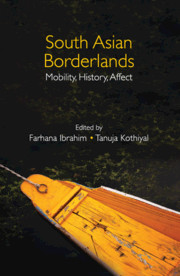Book contents
- Frontmatter
- Contents
- List of Figures and Tables
- Acknowledgements
- Introduction
- 1 Paradise at the Frontier: Kashmir as a Political Terrain and Literary Landscape in the Mughal Empire
- 2 Borders in the Age of Empire and Nation-States: The Honeycomb of Borderlands: Kumaun, Western Tibet and Far Western Nepal
- 3 Borders, Difference, Recognition: On the Cause(s) of Gorkhaland
- 4 Embattled Frontiers and Emerging Spaces: Transformation of the Tawang Border
- 5 Relative Intimacies: Belonging and Difference in Transnational Families across the Bengal Borderland
- 6 Reading Parijat in Nepal: The Poetics of Radical Feminism Negotiating Self and Nation
- 7 Commodity Journeys and Market Circuits: Making Borders ‘Natural’ in Colonial Western Himalayas
- 8 Frontiers, State and Banditry in the Thar Desert in the Nineteenth Century
- 9 Bureaucracy and Border Control: Ethnographic Perspectives on Crime, Police Reform and ‘National Security’ in Kutch, 1948–52
- 10 Frontier as Resource: Law, Crime and Sovereignty on the Margins of Empire
- About the Contributors
- Index
4 - Embattled Frontiers and Emerging Spaces: Transformation of the Tawang Border
Published online by Cambridge University Press: 17 September 2021
- Frontmatter
- Contents
- List of Figures and Tables
- Acknowledgements
- Introduction
- 1 Paradise at the Frontier: Kashmir as a Political Terrain and Literary Landscape in the Mughal Empire
- 2 Borders in the Age of Empire and Nation-States: The Honeycomb of Borderlands: Kumaun, Western Tibet and Far Western Nepal
- 3 Borders, Difference, Recognition: On the Cause(s) of Gorkhaland
- 4 Embattled Frontiers and Emerging Spaces: Transformation of the Tawang Border
- 5 Relative Intimacies: Belonging and Difference in Transnational Families across the Bengal Borderland
- 6 Reading Parijat in Nepal: The Poetics of Radical Feminism Negotiating Self and Nation
- 7 Commodity Journeys and Market Circuits: Making Borders ‘Natural’ in Colonial Western Himalayas
- 8 Frontiers, State and Banditry in the Thar Desert in the Nineteenth Century
- 9 Bureaucracy and Border Control: Ethnographic Perspectives on Crime, Police Reform and ‘National Security’ in Kutch, 1948–52
- 10 Frontier as Resource: Law, Crime and Sovereignty on the Margins of Empire
- About the Contributors
- Index
Summary
In 1964, in the aftermath of the India–China war of 1962, the Indian government sanctioned the construction of the Nehru Gonpa (Tib. dgon pa), a monastery to commemorate the visit of India's first prime minister, Jawaharlal Nehru, to Tawang, a far-flung border in northeast India. Locals narrate how stones and bricks from an older kakaling, a square arch that serves as an entrance gate to the area, were used to lay the foundation of the new monastery. The Nehru Gonpa, originally built as a kakaling, was later rebuilt as a monastery and the charge of its maintenance given over to the Tawang Monastery, which controls the other monasteries in the area. Nehru Gonpa or Nehru Dolma Lakhang now stands in Tawang's Nehru Market area as a symbol of the new relations between the Indian state and Tibetan Buddhist institutions that were being forged in that early postcolonial period in India's north-east frontier.
The year 1962 was a watershed moment in the post-colonial history of Tawang. Having more or less continued until the early 1950s, the policy of loose administration in frontier areas begun by the British colonial government, the Indian government rethought its administrative strategies from a strict security perspective as boundary disputes with China intensified. This meant establishing political offices and agents in untouched frontier regions, including the first paramilitary post in Tawang in 1951. Tawang was of particular strategic importance as it was coveted by the Chinese state as an extension of Tibet, since it had been under Tibetan rule for more than three centuries. When border tensions blew up into a full-scale Sino–Indian war, offices, residences and monasteries were temporarily evacuated as Chinese troops overran Tawang for two months from October to December 1962.
The war hastened the process of state consolidation in Tawang. As the Indian government set up military bases and administrative quarters in Tawang, cooperatives, retail stores and other civic infrastructure also followed in a stateenabled urbanisation process in order to cater to the needs of the military population and the new administrative, business and professional classes, who started trickling in from the early 1970s onwards. How did the people of Tawang respond to the new government and to the politico-economic and demographic changes it initiated?
- Type
- Chapter
- Information
- South Asian BorderlandsMobility, History, Affect, pp. 102 - 122Publisher: Cambridge University PressPrint publication year: 2021

